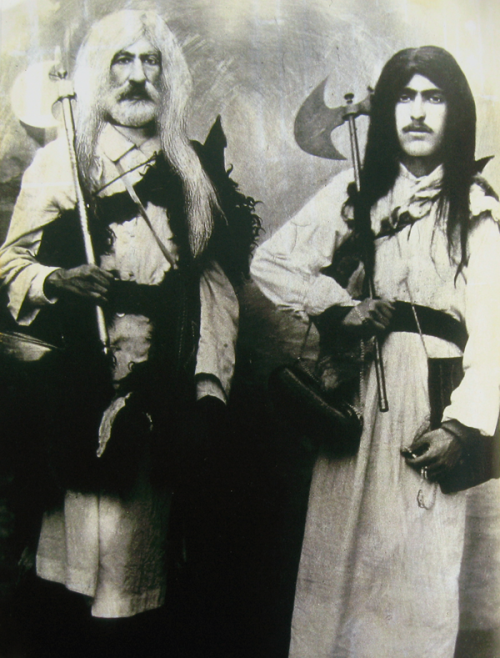
We say the seven blessings when there are guests for whom we provide more food, who are called "new faces." And some say that Shabbat and festivals are also "new faces" at the meals of the night and morning, but not at the third meal, and so did the custom spread. Rama: But now the practice in these Ashkenazi countries is to recite the seven blessings at the third meal too, and it's possible it's because usually "new faces" come anyway; while others say that the reason is that we usually give a sermon, and the sermon is like "new faces."
(י) חדשות. וצ''ע אם פורים נקר' פנים חדשות כנה''ג:
We need to reflect whether Purim is also considered a 'new face'.
(ח) מותר לישא אשה בפורים: הגה בין בי"ד בין בט"ו וכ"ש שמותר לעשות פדיון הבן (תוס' פרק קמא דמועד קטן) מה שנהגו ללבוש פרצופים בפורים וגבר לובש שמלת אשה ואשה כלי גבר אין איסור בדבר מאחר שאין מכוונין אלא לשמחה בעלמא
It is permitted to get married on Purim.
Rama: As to the custom of wearing 'faces' on Purim, and men who wear women's dresses and women wearing men's attire - this is not forbidden, for they have no intention other than pure pleasure.
מִזְרָק אֶחָד כֶּסֶף (במדבר ז, יט), כְּנֶגֶד הַתּוֹרָה הַמְשׁוּלָה בְּיַיִן, שֶׁנֶּאֱמַר (משלי ט, ה): וּשְׁתוּ בְּיַיִן מָסָכְתִּי. וּלְפִי שֶׁדֶּרֶךְ הַיַּיִן לִשְׁתּוֹת בְּמִזְרָק, כְּמָה דְתֵימָא (עמוס ו, ו): הַשֹּׁתִים בְּמִזְרְקֵי יַיִן, לְכָךְ הֵבִיא מִזְרָק, (במדבר ז, יט): שִׁבְעִים שֶׁקֶל בְּשֶׁקֶל הַקֹּדֶשׁ, לָמָּה, כְּשֵׁם שֶׁיַּיִן חֶשְׁבּוֹנוֹ שִׁבְעִים, כָּךְ יֵשׁ שִׁבְעִים פָּנִים בַּתּוֹרָה.
One basin of silver – corresponding to the Torah which is compared to wine, as it is stated, “and drink from the wine that I have mixed...”
Why? Just like the numerical equivalent of wine is seventy, so too are there seventy faces to the Torah.
הוי אלא למ"ד מבזה תלמיד חכם עצמו אפיקורוס הוי מגלה פנים בתורה כגון מאי כגון מנשה בן חזקיה
What is the meaning of 'revealing the face of Torah'? Like what individual does such a person conduct himself? He is like Manasseh, son of Hezekiah
Manasseh ben Hezekiah, king of Israel, would sit and teach flawed interpretations of Torah narratives. Manasseh said: But did Moses need to write only insignificant matters that teach nothing, for example: “And Lotan’s sister was Timna” (Genesis 36:22), or: “And Timna was concubine to Eliphaz, son of Esau” (Genesis 36:12)
In any event, what is the significance of the phrase in the verse “And Lotan’s sister was Timna”? The Gemara explains: Timna was the daughter of kings, as it is written: “The chief of Lotan” (Genesis 36:29), and: “The chief of Timna” (Genesis 36:40), and each chief is a member of a monarchy, albeit without a crown. That is why they are called chief and not king. Timna sought to convert. She came before Abraham, Isaac, and Jacob, and they did not accept her. She went and became a concubine of Eliphaz, son of Esau, and said, referring to herself: It is preferable that she will be a maidservant for this nation, and she will not be a noblewoman for another nation. Ultimately, Amalek, son of Eliphaz, emerged from her, and that tribe afflicted the Jewish people. What is the reason that the Jewish people were punished by suffering at the hand of Amalek? It is due to the fact that they should not have rejected her when she sought to convert.
וְעַל־כֵּן צֵרוּף שֶׁל פּוּרִים מְרֻמָּז בְּפֶסַח, בַּפָּסוּק (שמות כ״ג:ט״ו): שִׁבְעַת יָמִים תֹּאכַל מַצּוֹת כַּאֲשֶׁר צִוִּיתִךָ לְמוֹעֵד חֹדֶשׁ הָאָבִיב, כִּי בוֹ יָצָאתָ מִמִּצְרָיִם וְלֹא יֵרָאוּ פָנַי רֵיקָם. מִמִּצְרָיִם וְלֹא יֵרָאוּ פָנַי רֵיקָם – רָאשֵׁי־תֵבוֹת פּוּרִים, כִּי פּוּרִים הוּא דֶּרֶךְ לְפֶסַח, שֶׁיִּהְיוּ יְכוֹלִים לִהְיוֹת נִזְהָרִין מֵחָמֵץ:
(וּפָסַק בְּאֶמְצַע הָעִנְיָן וְלֹא גִּלָּה יוֹתֵר).




